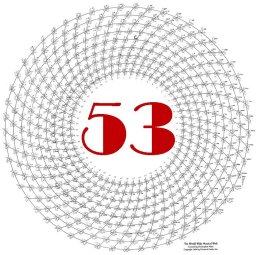Next Page: 11/3 – Scales and Triads
Chapter 11: Major-minor systems 1500-present
12-eq enharmonics vs 53-eq enharmonics
What classical music does best and must always do more, is to show this kind of transformation of moods, to show a very wide psychological voyage. And I think that’s something that we as classical musicians have underestimated. –Michael Tilson Thomas
Europe’s “common practice period” (approximately 1600-1900) is the musical foundation of classical, jazz, pop, and much of world music today. Technically, it’s an approach to harmony where chords are built up from their bass notes (the word “chord” is a shortening of the word “accord,” implying that the notes being sounded are somehow “in accord” with one another). Tonality is a system where all these chords and melodies orbit around a single tonic, or home, note. Within tonality it is possible, even common, to change that home note, and modulate (say, from C to E). But Almost all tonal traditions during the common practice period require that a piece end with the same tonic with which it began. The tonic note is usually paired with its dominant note (C and G, for example) which then become the two ends of a musical seesaw between the tonic (or tonic-related) chords and the dominant-related chords. The tonic chord is reserved for periods of musical rest, and the dominant for periods of musical tension. Music in C major can have chromatic notes not found in the major or minor scales, but the C and G tend to remain as tonal anchors unless the music is moving towards a key change. Four of the six ancient Greek modes are largely abandoned, leaving only the Major (Ionian mode) and various Minor (Aeolian mode-derived) scales. The other four modes become but an occasional spice in the musical mix. The transition to common-practice-period musical forms began before 1600 (during the High Renaissance) and was nearly complete by 1650 (the beginning of the Middle Baroque Period). To an untrained ear, traditional tonal music is what almost everyone is most comfortable with. Any pre-tonal music from earlier than 1500 or so sounds weird to a closed-minded person, or exotic and cool to an open-minded one. After 1900, music that departs from the traditional harmonies and major-minor scales also sounds weird (or cool and exotic) to the inexperiencced listener.
For some styles like early jazz, the departure from the common-practice norms are noticeable but not completely foreign-sounding. For example, the chords pile on ninths, elevenths and thirteenths. They create parallel voicings that are forbidden in common-practice music, which tends to make you feel a little less anchored in the home key than a classical piece would be. They often mask the chord progressions with suspensions and fascinating dissonances. They allow traditionally unresolved chords to hang in their air with no attempt to resolve to the tonic. But when you analyze traditional jazz, at its core you find it to be derived from common-practice methods….
If you would like to learn more about this chapter, “Major-minor systems 1500-present,” you can buy the entire book, The Grand Unified Theory of Music, in pdf form for $25 with hundreds of embedded musical examples of scales and chords from all over the world.
A free introduction to what The Grand Unified Theory of Music offers is on this website and includes both text and a few musical examples from each webpage. If you would like to learn more about this chapter and the full contents of this entire e-book, you can buy The Grand Unified Theory of Music for $25, with hundreds of embedded musical examples of scales and chords from all over the world — and ideas for how to set up your computer system —
HERE.
You’ll get a personalized password you can use to see the entire e-book. Inside the full book, you will also get a link to the complete pdf file of this e-book, which you can read on your Kindle or similar device. The links to the hundreds of mp3 sound files – the same ones you can hear on the website — will also be included. This is “Version 1.0” of The Grand Unified Theory of Music. Because it is an e-book, additions, corrections and improvements in the sound may be added at any time. The Grand Unified Theory of Music is Copyright © 2018 by Christopher Mohr. All rights reserved.
One person per password. Sharing this password with others is a violation of copyright. Do not allow others to use your password or link to the pdf file!
Next Page: 11/3 – Scales and Triads
